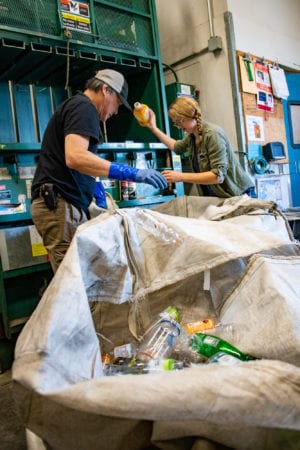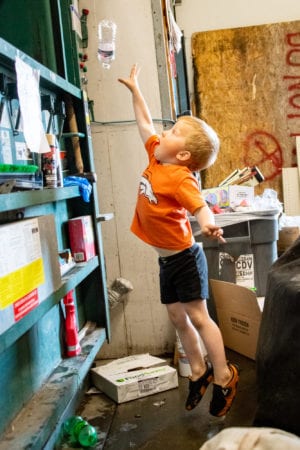
Recycling plastic seems simple enough: one collects a bunch of bottles, throws them in a baler, crushes them into a cube and then calls it a day. Shae Bowman, however, has found otherwise.
Bowman, the operations manager for the Copper River Watershed Project, is in charge of sorting the plastic bottles that come the CRWP’s way. A bale of bottles that are mismatched, dirty or otherwise carelessly selected may end up in a landfill rather than a recycling plant, Bowman says.
Not all plastic bottles are made of the same material. Most bottles are made of either “No. 1” plastic or “No. 2” plastic. No. 1 bottles, made of polyethylene terephthalate, are typically transparent and have dimples on their undersides. No. 2 bottles, made of high-density polyethylene, are more opaque and have seams on their undersides. A Coke bottle will be made of No. 1 plastic, whereas a one-gallon jug of milk will be made of No. 2 plastic.
No. 1 and No. 2 plastic cannot be combined during recycling, so the bottles have to be separated before baling. Additionally, No. 1 plastic from molded containers like fruit punnets cannot be combined with No. 1 plastic from blown containers like bottles. The simplest thing for the CRWP is if residents sort No. 1 bottles from No. 2 bottles before bringing them in, Bowman said.

“It’s so great when somebody brings in a bunch of plastic that’s sorted, that’s clean, that’s all in the same bag, and then we can just dump it into the baler,” Bowman said.
On Aug. 7, the CRWP held a plastic recycling drive at the AC Value Center loading dock, producing a full bale of No. 1 plastic bottles. Additional No. 2 plastic bottles have been stockpiled, hopefully to be baled at the next recycling event.
Bowman has seen her share of odd, if well-intended, items sent in for recycling, from buckets to toy trucks. As some items must sit in stockpiles for months before baling, it’s important that they be cleaned before being brought in, Bowman said. Additionally, all bottles must have their lids removed.
“The work can pile up fast on the volunteers,” Bowman said. “Last time, I got a big ol’ bag of plastic bottles. They were all sorted, they were all clean, but every single bottle had a lid on it. I sat there and unscrewed every single lid, and I was super annoyed.”
The CRWP’s biggest contributor of bottles on Aug. 7 was Laura’s café, Bowman said. Residents are encouraged to bring suitable plastic bottles to the CRWP’s next recycling drive, scheduled for Sept. 25 at AC Value Center.





